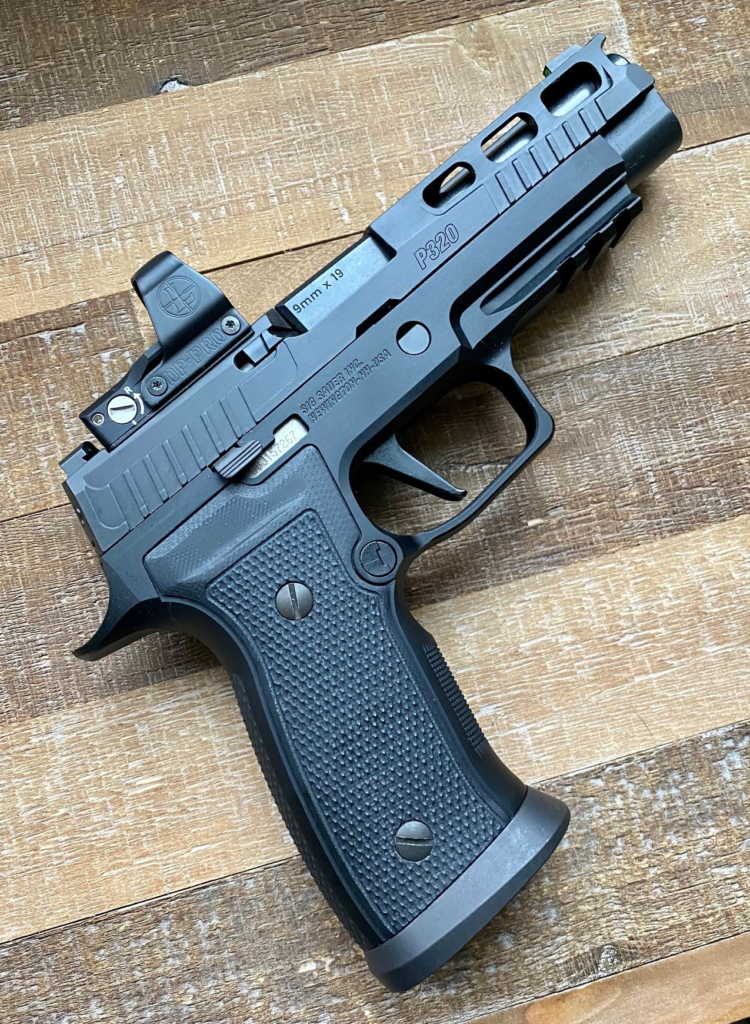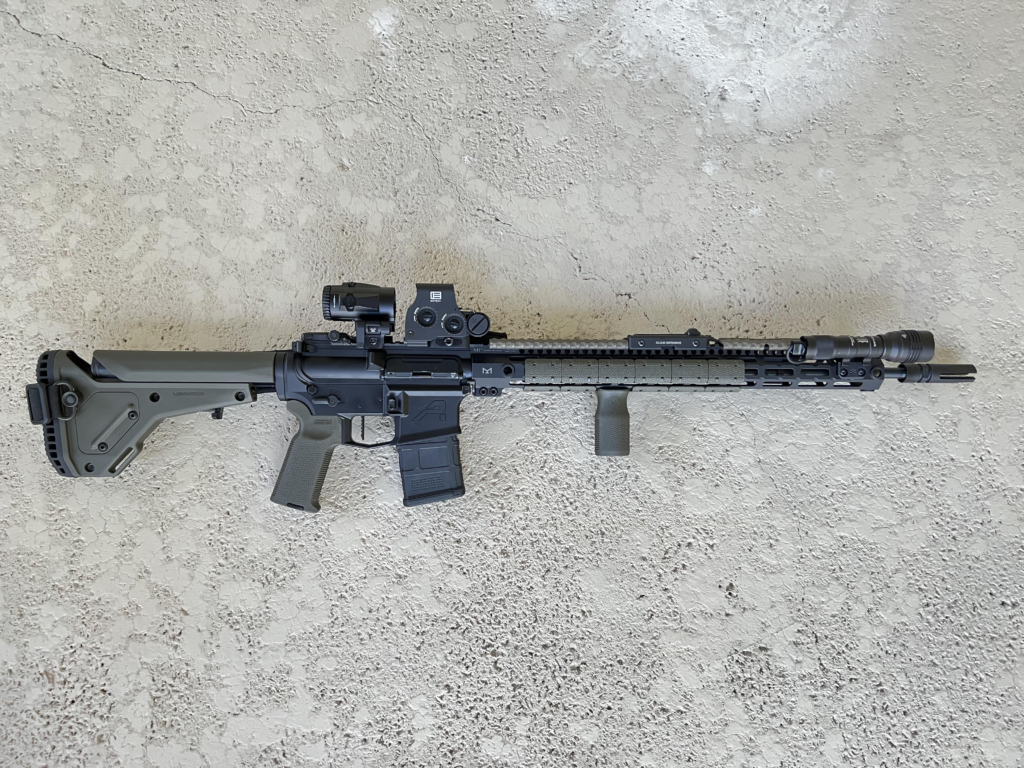Let’s face it: this world is one solar flare away from returning to the 1800’s. It’s up to you to be prepared. Part of that preparation should include firearms. This article will point those of you who aren’t like this editor (HI, my name is KITDAFBS and I’m a gunaholic) in the right direction.
There are a couple of criteria to look at when assembling your TEOTWAKI (The End Of The World As We Know It) arsenal. Whether you’re looking for a pistol, rifle or shotgun – and I suggest all three – the same basic criteria apply: ammo availability, capacity, reliability/availability of spares and accuracy.
Pistols

I recently wrote about the best carry concealed caliber. In that article, I wrote that 9mm is the best caliber for concealed carry. For many of the same reasons, 9mm is my first choice for SHTF. Not only is 9mm the most commonly available pistol cartridge, it’s reasonably potent. 9x19mm NATO is also lighter compared to, say, .45 ACP. That allows you to carry more rounds for a given weight.
As far as the guns themselves go, for SHTF, I’m going with a duty or full-sized pistol (4.5″-5+” barrels). I’m going with something like the Glock 17/19/34, Sig P320 or P226/9, Beretta M9 or the like. All three of those brands have a well-deserved reputation for reliability and with the exception of the Sigs finding replacement parts shouldn’t be that difficult. Why a duty/full-sized pistol over something smaller and concealable? In a SHTF scenario, I’m not worried about hiding my sidearm from anyone. Additionally, the extra barrel length can provide better accuracy because of the longer sight radius.
That’s not to say the 1911 doesn’t have a place in TEOTWAKI. It does. It’s just not going to be my first choice. While a well sorted 1911 is an absolute joy, one that has even the most minor thing wrong with it, and I’m including being dirty, can be a finicky beast. Unlike most modern pistols, the 1911 requires fitting for most replacement parts (extractor, I’m looking at you. . . ) and a competent ‘smith for just about any repair. Meanwhile, I’ve seen broken Glocks returned to service with duct tape and baling wire.
If you’re a wheel-gun person, make sure you have ample stocks of ammo for your piece. 20-30 years ago, it wouldn’t have been hard to find ammo for .38 spcl or .357 magnum. Today, well good luck. With the current ammunition market, .38 and .357 have become much rarer, .44 mag almost non-existent and god forbid you have something like .327 federal. . . To be honest, handloading is basically your only chance.
Ammo

While we’re on the subject of ammo, a couple of thousand rounds is a good start for handguns. I’d say the same for shotshells, but I would look at tripling that number if my primary long gun was going to be a scatter-gun. As far as ammo for my primary rifle goes, I think you should have something between 5 and 10 thousand rounds on hand. Remember, you aren’t going to be able to just run to the local Wally-World and grab another box or two when you need it.

You also need to store your ammo correctly. I have a dedicated ammo locker that has a dehumidifier running all the time. I also store ‘ready’ ammo in surplus steel ammo cans. I usually chuck a couple of those desiccant packs in with the ammo, just to keep the moisture down. For most folks, the ammo can is the way to go. It’s compact, stackable, easily obtained and easy to transport. For reference, you can get about 1200 rounds of 9mm in one .30 cal ammo can (pictured above).
Shotguns

I will be the first to admit I am not a shotgun guy. I prefer, and if I’m being honest far more proficient with, rifles and pistols. That said, the shotgun most certainly has a place in your SHTF arsenal. The shotgun is the most versatile platform in that situation. You can use it to fill the cook-pot and defend yourself.
So, what type of scatter-gun should you be looking for? A 12 gauge repeater of some sort, either pump or auto-loader, with interchangeable choke tubes or barrels from one of the reputable manufacturers. I’d avoid the ‘bargain’ Turkish brands, but that’s me.
Whatever way you decide to go, pump or auto-loader, make sure you have the proper shells to feed it in a variety of shot sizes. I’d (have) stock(ed) up on #6 shot (for small game) #3 shot (ducks) and bb shot (geese) as well as buckshot and slugs.
I have a couple of “tactical” shotguns in my collection, and they work well for the tasks they were designed for; breaching and close-range shooting. My Benelli M4 has an 18.5″ barrel, and most other “tactical” shotguns are in that range. I’d consider that length barrel sub-optimal for hunting birds, either upland or waterfowl. Will it work for birds? Yes, but. . .
When SHTF I’m going with a field gun (26-28″ barrel) because a rifle is going to be my primary long gun.
Rifles

Get a 20″ AR chambered in 5.56 NATO. Really, that’s my advice for rifles. Why an AR? Easy, it’s commonly available, easy to work on if something breaks and parts are all over the place. The caliber recommendation is slightly more nuanced, you can fire .223 rem in a 5.56 chambered gun safely, but not the other way around. There are other factors too, like ammo availability, and weight per round that mitigate against other AR calibers like .300BLK.
I’d want something with a 20″ barrel, to maximize the performance in 5.56 NATO. 16″ barrels look cool, but based on the testing I’ve seen you go from around 3200 fps with a 55gr M193 out of a 20″ barrel to 2800 fps out of a 16″. That’s a pretty big drop for not a lot of benefit. It gets worse with 62 gr M885 and 77gr MK 313 rounds.
You can find decent quality ARs for less than a thousand bucks. Palmetto State Armory is one ‘bargain’ AR that I’d look at if I needed a cheap rifle. Looking at the PSA site, they have a 16″ rifle for $659.99. I’d also look for a ‘flat-top’ rifle vice a carry-handle. It makes optics mounting much easier.
Optics



Yes, you need optics. 30 years ago, while I was still a young paratrooper, I’d have said optics are contraindicated on a combat rifle. Now, I say irons are contraindicated. Simply put, a proper combat optic is easier to use than irons, especially in a high-stress situation. Twenty years of the GWOT have put to rest the idea that optics aren’t robust enough for combat.
The question becomes what optic? I can’t answer that question for you, at least not directly.
I have a few preferences, learned through experience, in what optic I run on any of my firearms. My primary AR, the one I regularly train with, wears a Vortex Razor 1-6×24 LPVO with a Vortex Viper reflex sight on a 45 degree offset mount. For the terrain around here, the additional magnification is a must. The offset mounted reflex gives me a quick and dirty way to engage close-in surprises. If I was in a more urban setting, I’d likely run something like the EOTech XPS line or one of the red dot sights from Vortex or Primary Arms with a flip-away magnifier like the setup pictured above the rifle section
Are either of those setups right for you? I don’t know for sure. Maybe you live out west. If that’s the case, look for a ‘traditional’ rifle scope with plenty of magnification. Whatever optic choice works for you, do not cheap out. I’m not saying run out and buy a $10k Schmidt and Bender or Unertl. There are plenty of quality optics in the $200-300 range. I recommend you avoid the cheap chinesium imports.
While we’re looking at optics, I’m going to take a paragraph and discuss lights. Get yourself a good one. It should be LED, take replaceable batteries and have at least 500 lumens of output. Make sure you have a good supply of batteries.
Weight
As this isn’t a big concern for me personally, I’m in my mid 50s and I still regularly ruck with 80lbs, so I had WhiteKnightLeo write the following section.
Weight isn’t a category mentioned at the top – that’s because Leo is here to add this section. The watchword for you when TEOTWAKI is to take very careful note of how much your stuff weighs. In a breakdown of social order, odds are most of us are going to be staying close to home – but that won’t be an option for everyone. Worse, some of us who chose to stay will be forced to leave.
When you’re at home, having a fully-loaded Kel-Tec KSG-25 with a full-length shell rack won’t be too much hassle – despite it weighing in at nearly 16lbs. But if the rioters suddenly set your neighborhood on fire, that’s going to be quite the mass to haul around, in addition to your bug-out bag and anything else you have to flee with.
A 25-round box of 00 shotshell weighs about 2.5lbs.
50 rounds of 9x19mm NATO clocks in at 1.34lbs.
50 rounds of 5.56x45mm NATO weighs 1.41lbs.
All of that is just fine when it’s sitting on your garage floor – not so much when you try to load it into your car, or if you’re forced to hoof it.Lighter weapons and smaller calibers do tend to sacrifice ballistic performance, but the benefit you get is portability and maneuverability. In the hands of a sufficiently-skilled marksman, a lot can be accomplished with a .22WMR, and you can easily carry a lot more ammunition, even on foot – 50 rounds of .22WMR weigh in at only 0.56lbs.
So if you want to run heavy – which should depend on whom you think will target your neighborhood in the event of TEOTWAKI, and how defensible said locale is – you really want to keep up on your fitness.

Kitdafbs again. In other words don’t be ⬆that guy. I regularly run into a guy like that at the range, and I told him straight up that if the world goes pear-shaped, I’m shooting him first and taking anything I think is useful.
Spares
Spare parts are an often overlooked subject when it comes to SHTF. Keep in mind, you aren’t going to be able to call up Brownells and order a replacement firing pin for your gat. Do yourself a favor and build a small stockpile of the items you need to keep your firearms running. Firing pins, various springs and AR bolt gas rings are all items that wear out or break relatively regularly. Do a little research and find out what tends to break/wear out on the firearms you have, and buy them. Teach yourself how to replace them as well.
Get a supply of batteries too. If you’re running anything with an illuminated reticle, including red dots and reflex sights, you need spare batteries. Lay in a supply of CR123, AA, AAA, and whatever coin cell batteries you may need for your optics. Store them in an airtight, waterproof container away from extreme temperature changes and they will stay fresh and fully charged for a good long time.
As always, if you have any questions about anything discussed in this article, hit me up in the comments below.